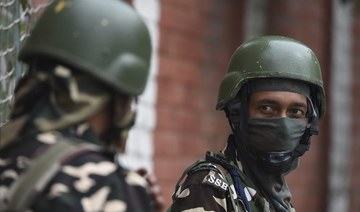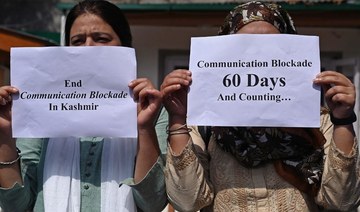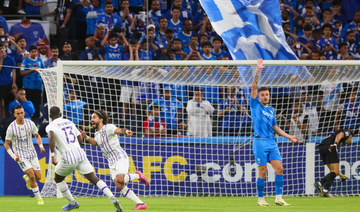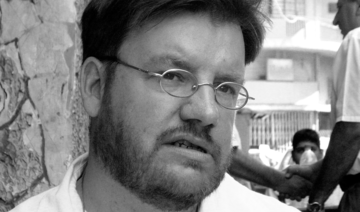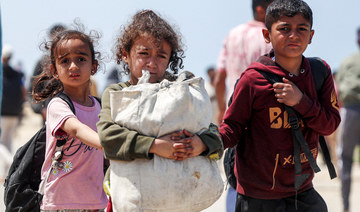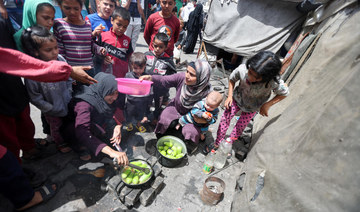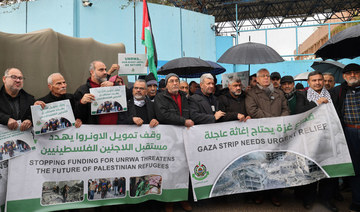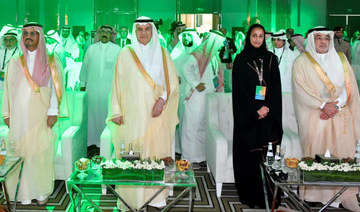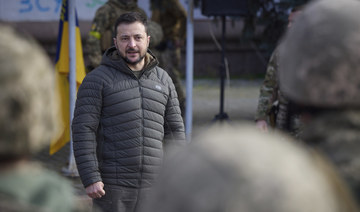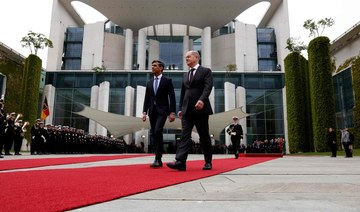SRINAGAR, India: At least nine people were killed Sunday in firing along the de facto India-Pakistan border in Kashmir, officials said, adding to the spike in deaths in recent days as New Delhi eased a curfew in the disputed region.
Tensions escalated between the nuclear-armed neighbors after India revoked Kashmir’s autonomy on August 5 and imposed movement and communications restrictions to quell unrest.
Officials from the two countries accused each other of firing mortar rounds and small arms along the so-called Line of Control.
“Two soldiers and a civilian were killed and three others injured in the unprovoked fire by Pakistan,” Indian Army spokesman Col. Rajesh Kalia said of the “unprovoked” fire in the mountainous Tangdhar region of Kupwara district.
Several homes were damaged in the attack and three civilians were being treated in a hospital, he added.
Officials in Pakistan-administered Kashmir said six civilians were killed and eight others wounded in Muzaffarabad and Neelum Valley.
“Mortar shells hit civilian houses and have so far martyred five people in Muzzafarabad and wounded six others,” said Muzaffarabad deputy commissioner Badar Munir said.
Munir said the dead included three members of one family.
Neelum Valley official Akhtar Ayub said one civilian was killed and two injured.
The shelling came after five people were killed in Indian Kashmir on Wednesday, two days after New Delhi restored mobile phone and text services.
Indian authorities said repeatedly during the lockdown that Kashmir has been mostly peaceful.
Kashmir has been split between India and Pakistan since 1947 and was the spark of two wars and numerous skirmishes.
An armed rebellion against Indian rule has raged in the valley since 1989, claiming tens of thousands of lives, mostly civilians.
Nine killed in fresh firing across Kashmir border
Nine killed in fresh firing across Kashmir border
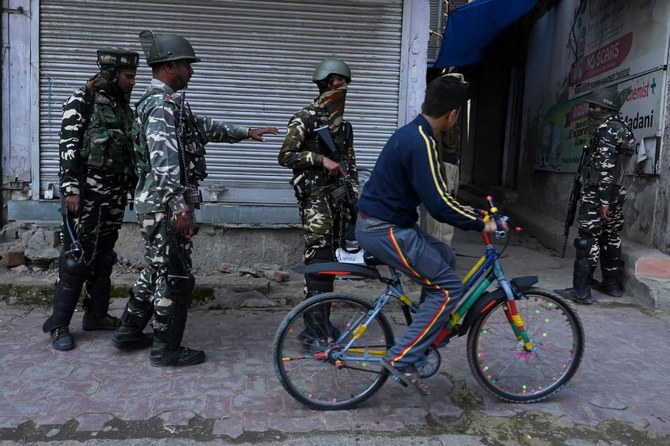
- Tensions escalated between the nuclear-armed neighbors after India revoked Kashmir’s autonomy on August 5
- Officials from the two countries accused each other of firing mortar rounds
Kewell’s Yokohama beat Ulsan to reach Asian Champions League final
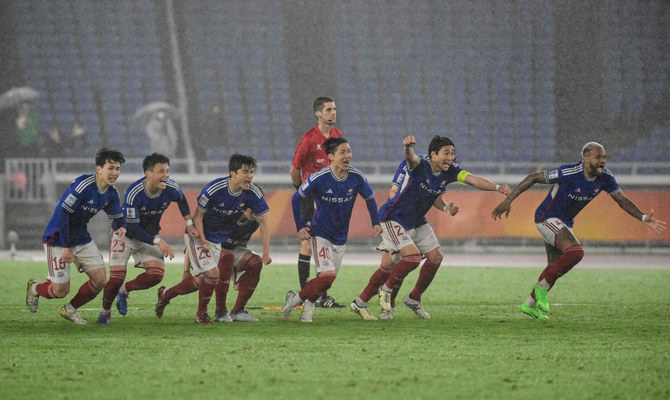
- Yokohama will host Al Ain in the first leg of the final on May 11, with the return being held in the UAE on May 25
YOKOHAMA: Harry Kewell said his Yokohama F-Marinos players can “handle any pressure” after beating Ulsan Hyundai 5-4 on penalties on Wednesday to set up an Asian Champions League final against Al Ain.
Former Liverpool and Leeds forward Kewell’s side came through a pulsating semifinal that ended 3-3 on aggregate to reach the Champions League final for the first time.
Trailing 1-0 from last week’s first leg in South Korea, Yokohama scored three goals in the opening 30 minutes in Japan but then conceded twice and had a man sent off before halftime.
Goalkeeper William Popp saved from Ulsan’s Kim Min-woo in the shootout to hand Yokohama the advantage in constant driving rain, before Carlos Eduardo converted the decisive spot kick.
Kewell, who took over as Yokohama coach at the start of the year, said he told his players that “the hardest games you will play are semifinals.”
“I said: ‘Nothing easy in this game’,” said the Australian.
“You are going to get pushed to the limit where I believe you can handle it.
“I think it showed them tonight, they believe now they can handle any kind of pressure.”
Yokohama will host Al Ain in the first leg of the final on May 11, with the return being held in the UAE on May 25.
Al Ain beat Saudi Arabia’s Al-Hilal 5-4 on aggregate on Tuesday to reach the final.
Yokohama looked certain to join them after a barnstorming start to the second leg but two goals for Ulsan and a 39th-minute red card for defender Takumi Kamijima cranked up the tension.
Ulsan laid siege to the Yokohama goal but Kewell said his players grew in stature as the game went on.
“The players were composed, they were confident,” he said.
“They were getting stronger and stronger as they got closer to the final whistle.”
Ulsan, who had already booked their place in next year’s 32-team Club World Cup in the US by winning the semifinal first leg, were looking for their third Champions League title.
“My players kept going until the end,” said coach Hong Myung-bo.
“It’s unfortunate because we had a lot of chances to score in both the first and second legs.”
Yokohama took the lead in the 13th minute when a defensive mix-up between Kim Young-gwon and Hwang Seok-ho allowed Asahi Uenaka to streak through and score.
Anderson Lopes added a second in the 21st minute, firing home a left-foot shot from just inside the box.
The home side kept up the pressure and Uenaka notched his second of the game on the half-hour mark when he slipped his marker and curled a shot past goalkeeper Jo Hyeon-woo.
But just as it looked like turning into a rout, Ulsan hit back when Matheus Sales headed home direct from a corner in the 35th minute.
Moments later, Ulsan had a penalty and Yokohama were reduced to 10 men when Kamijima was red-carded for a handball as he slid in to make a tackle.
Substitute Darijan Bojanic, who had come on in the 34th minute, made no mistake from the spot.
Kewell admitted Yokohama “rode our luck at times” as they held off Ulsan but said his players “deserved everything they got.”
“We’re going to enjoy the final,” he said.
“You don’t get a chance to play many finals in your career so when you do, enjoy it and play the way that you’re born to play.”
Columbia University extends talks with students, averting police action
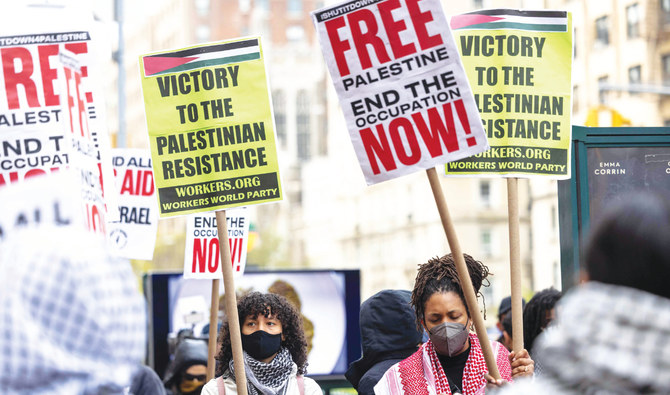
- Standoffs persist at other universities across US, including California State Polytechnic, Humboldt
NEW YORK/JERUSALEM: Columbia University averted another confrontation between students and police on Wednesday, but the situation remained tense with campus officials saying it would continue talks with pro-Palestinian protesters for another 48 hours.
University President Minouche Shafik had set a midnight deadline to reach an agreement on clearing an encampment of protesters on campus but the school extended negotiations, saying it was making “important progress.”
Student protesters had committed to dismantling and removing a significant number of tents, the New York Ivy League university said in a statement.
On Wednesday morning, the encampment appeared calm and a little smaller than the previous day.
Standoffs also persisted at other universities across the country, including California State Polytechnic University, Humboldt, where protesters this week used furniture, tents, chains and zip ties to block a building’s entrance and barricade themselves inside.
And new student encampments continued to pop up, including at Brown University in Rhode Island.
Police first tried to clear the encampment at Columbia last week, when they arrested more than 100 protesters. But the move backfired, acting as an inspiration for other students across the country to set up similar encampments and motivating protesters at Columbia to regroup.
Students protesting Israel’s war with Hamas are demanding schools cut financial ties to Israel and divest from companies enabling its monthslong conflict.
Dozens have been arrested on charges of trespassing or disorderly conduct. Some Jewish students say the protests have veered into antisemitism and made them afraid to set foot on campus.
The reprieve at Columbia came hours before Republican US House Speaker Mike Johnson planned to visit and meet with Jewish students to address antisemitism on college campuses.
Columbia said it had agreed with protest representatives that only students would remain at the encampment and they would make it welcoming, banning discriminatory or harassing language.
Elsewhere, at the University of Minnesota, Democratic US Rep. Ilhan Omar attended a protest late on Tuesday, hours after nine protesters were arrested on the campus when police took down an encampment in front of the library.
Hundreds had rallied in the afternoon to demand their release.
Omar’s daughter was among the demonstrators arrested at Columbia last week.
Also on Tuesday, police arrested more than 200 protesters blocking traffic in Brooklyn, near the home of Sen. Chuck Schumer, during a non-college demonstration demanding a permanent ceasefire in Gaza The protest was organized by Jewish Voice for Peace on the second night of Passover.
At Cal Poly Humboldt, protesters chanted, “We are not afraid of you!” before officers in riot gear pushed into them at the building’s entrance, video shows.
Three students were arrested, according to a statement from the school, which shut down the campus through Wednesday. Students had occupied a second campus building Tuesday.
Students at some protests were hiding their identities. At an encampment of about 40 tents at the heart of the University of Michigan’s campus in Ann Arbor, almost every student wore a mask, which was handed to them when they entered.
At New York University this week, police said 133 protesters were taken into custody and all had been released with summonses to appear in court on disorderly conduct charges.
More than 40 protesters were arrested Monday at an encampment at Yale University.
Harvard University in Massachusetts has tried to stay a step ahead of protests by locking most gates into its famous Harvard Yard and limiting access to those with school identification.
Meanwhile, Hamas published a video apparently showing Hersh Goldberg-Polin, an Israeli-American seized during the Oct. 7 attack on Israel and taken hostage into Gaza, alive.
The short video, which is undated, showed the 23 year-old missing his lower arm, which was blown off during the Hamas-led attack in October, but otherwise apparently healthy.
His mother Rachel Goldberg-Polin has been campaigning actively for the release of her son, who was abducted at the Nova music festival that was attacked by Hamas gunmen on Oct. 7 and is one of 133 Israeli hostages still in captivity after over 100 were freed.
Saudi Arabia welcomes independent committee’s report on UNRWA’s performance
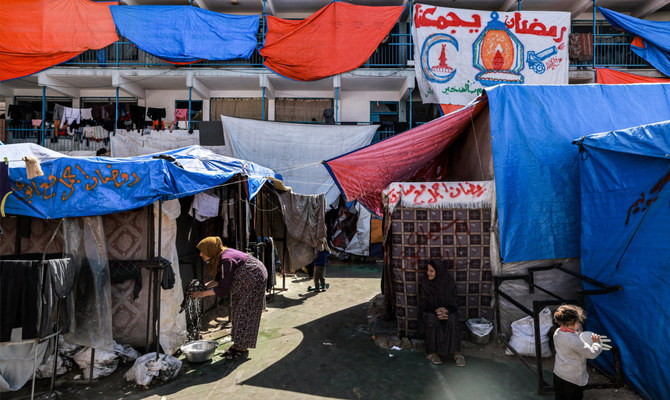
- Saudi Ministry of Foreign Affairs stresses importance of the commitment of donor countries to the organization
RIYADH: Saudi Arabia has welcomed an independent committee’s report on the performance of the UN Relief and Works Agency for Palestine Refugees, the Saudi Press Agency reported on Wednesday.
The Saudi Ministry of Foreign Affairs said the Kingdom backed the report, which confirmed UNRWA’s main role in supporting the relief, humanitarian and developmental efforts of the Palestinian people.
The ministry further reiterated Saudi Arabia’s emphasis on the importance of the commitment of donor countries to UNRWA to ensure the sustainability and effectiveness of all forms of support for refugees in a way that reduces their suffering, especially in light of the Israeli occupation’s continued violations of international law and international humanitarian law.
EU Embassy, Arab News honor makers of Saudi ‘Horizon’ documentary
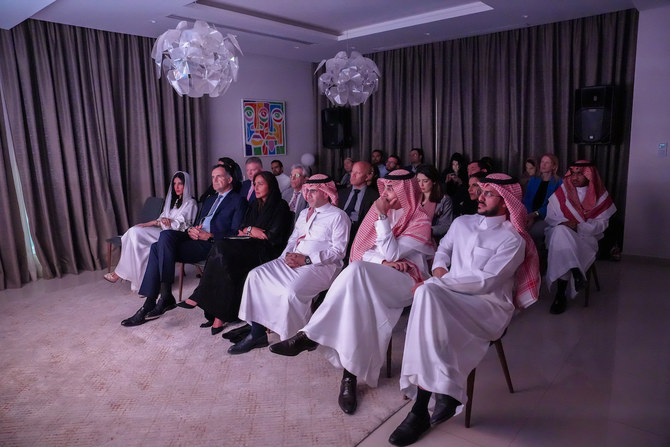
- Princess Lamia: ‘Screening is a reminder of our shared responsibility to protect precious ecosystems’
- Ambassador Farnaud: ‘The Saudi Green Initiative and the European Green Deal have shared goals’
- Abbas: ‘We are delighted to partner with the EU envoy to showcase Saudi Arabian wildlife in a captivating manner’
RIYADH: The makers of a recently produced, highly acclaimed documentary on Saudi wildlife were honored at a special screening of the film “Horizon” at the residence of the EU ambassador in Riyadh.
The new documentary, produced by the Konoz Initiative, is part of a collaboration between the Saudi Ministry of Media’s Center for Government Communication and the National Center for Wildlife.
It explores the ecological treasures and unique habitats of the Kingdom.
Princess Lamia bint Majed Saud Al-Saud, secretary-general of Alwaleed Philanthropies, was a guest of honor. Princess Lamia, through her work with Alwaleed Philanthropies, has recently announced an initiative called Atlai, an innovative artificial intelligence platform to support global efforts to combat deforestation.
The screening was followed by a presentation of an honorary certificate to Abdullah Alahmari, CEO of Konoz initiative, and Yazeed Albader, associate producer of “Horizon.” This was presented by EU Ambassador to Saudi Arabia Christophe Farnaud, Princess Lamia and Arab News Editor-in-Chief Faisal Abbas.
Farnaud said: “The ‘Horizon’ documentary captures the breathtaking beauty of Saudi Arabia’s diverse natural landscapes and wildlife.
“For centuries, much of the Arabian Peninsula, including Saudi Arabia, held a mysterious attraction for European explorers and travelers.”
The ambassador spoke of the significance of protecting the environment due to basic human needs such as food and water, and dependency on the health of our global environment.
“The Saudi Green Initiative and the European Green Deal have shared goals. We all depend on nature for our food, air, water, energy and raw materials. Nature and biodiversity make life possible, provide health, and drive our economy. Nature is also our best ally in tackling the climate crisis,” he said.
“Climate change, economic diversification and transitioning to renewables remain priority areas for both the EU with its policy of European Green Deal as well as for Saudi Arabia with its Vision 2030.”
Princess Lamia gave her thoughts on Saudi Arabia’s fascinating natural wonders that are featured in the film.
“Through ‘Horizon’ we are transported to the breathtaking beauty and rich biodiversity of Saudi Arabia. This documentary promises to immerse us in the heart of the Kingdom’s diverse wildlife and scenery,” she said.
“Tonight’s screening is not only a celebration of Saudi Arabia’s rich natural heritage but also a call to action — a reminder of our shared responsibility to protect and conserve the precious ecosystems that define our world.
“In a time where our forests and natural ecosystems are disappearing at an alarming rate, Atlai, created by Alwaleed Philanthropies, is a testament to the power of innovation and collaboration. It’s about igniting a passion for preservation, a fervor for conservation, and a commitment to safeguarding our planet for generations to come.”
Abbas expressed appreciation for the Saudi team behind the “Horizon” documentary, saying: “We are delighted to have partnered with the EU delegation to host a special screening of this remarkable documentary which showcases Saudi Arabian wildlife in a truly captivating manner.”
He added: “As part of Arab News Green and Blue initiative, which focuses on environment and sustainability, we are also proud to present the Saudi team behind the ‘Horizon’ documentary with a certificate of appreciation, and thank them for their contribution in preserving and showcasing the wonders our beloved Kingdom has to offer.”
Arab News has recently launched its Green And Blue, an initiative which discusses environmental subjects regarding climate change, desertification, wildlife preservation, sustainability, and green energy, with a close emphasis on the environment in Saudi Arabia.
The CEO of Konoz initiative expressed how thrilled he was to attend the screening of the movie.
“This documentary sheds light on the beauty of Saudi Arabia, its versatile terrain and highlights the wildlife we are blessed to have in the Kingdom,” Said Alahmari.
He expressed his appreciation to the Minister of Media Salman bin Yousef Al-Dossary for his constant support in ensuring that the movie highlights the Kingdom and reaches a broader audience.
The associate producer of the work explained how the documentary took more than 260 days of shooting and more than 2,000 hours of recording because it covered all the regions.
“If you want to shoot some of the animals, you may not get luck on the spot. So, you have to do some scouting, you have to arrive a couple of days before, stay for weeks to spot a nice shot, or to get that perfect skyline with the clouds, sunset or sunrise,” said Albader.
“I was honored to be here, the screening was great. It is a pleasure to be here with the ambassadors, and to see how a lot of people care about nature and wildlife. This is just the beginning of many events to come.”
“Horizon” is now available on Netflix internationally.
Ukraine uses long-range missiles secretly provided by US to hit Russian-held areas, officials say
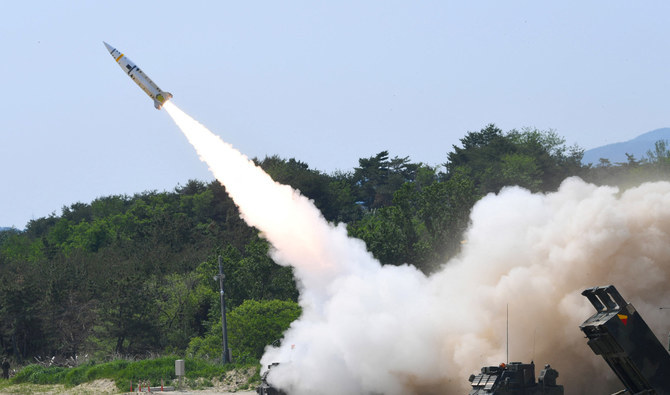
- The new missiles give Ukraine nearly double the striking distance up to 300 kilometers
- The two US officials would not provide the exact number of missiles given last month or in the latest aid package, which totals about $1 billion
WASHINGTON: Ukraine for the first time has begun using long-range ballistic missiles provided secretly by the United States, bombing a Russian military airfield in Crimea last week and Russian forces in another occupied area overnight, American officials said Wednesday.
Long sought by Ukrainian leaders, the new missiles give Ukraine nearly double the striking distance — up to 300 kilometers (190 miles) — that it had with the mid-range version of the weapon that it received from the US last October. One of the officials said the US is providing more of these missiles in a new military aid package signed by President Joe Biden on Wednesday.
Biden approved delivery of the long-range Army Tactical Missile System, known as ATACMS, in February, and then in March the US included a “significant” number of them in a $300 million aid package announced, one official said.
The two US officials, who spoke on condition of anonymity to discuss the delivery before it became public, would not provide the exact number of missiles given last month or in the latest aid package, which totals about $1 billion.
Ukraine has been forced to ration its weapons and is facing increasing Russian attacks. Ukraine had been begging for the long-range system because the missiles provide a critical ability to strike Russian targets that are farther away, allowing Ukrainian forces to stay safely out of range.
Information about the delivery was kept so quiet that lawmakers and others in recent days have been demanding that the US send the weapons — not knowing they were already in Ukraine.
For months, the US resisted sending Ukraine the long-range missiles out of concern that Kyiv could use them to hit deep into Russian territory, enraging Moscow and escalating the conflict. That was a key reason the administration sent the mid-range version, with a range of about 160 kilometers (roughly 100 miles), in October instead.
Adm. Christopher Grady, vice chairman of the Joint Chiefs of Staff, said Wednesday that the White House and military planners looked carefully at the risks of providing long-range fires to Ukraine and determined that the time was right to provide them now.
He told The Associated Press in an interview that long-range weapons will help Ukraine take out Russian logistics nodes and troop concentrations that are not on the front lines. Grady declined to identify what specific weapons were being provided but said they will be “very disruptive if used properly, and I’m confident they will be.”
Like many of the other sophisticated weapons systems provided to Ukraine, the administration weighed whether their use would risk further escalating the conflict. The administration is continuing to make clear that the weapons cannot be used to hit targets in Russia — only those inside Ukrainian territory, according to one of the US officials.
“I think the time is right, and the boss (Biden) made the decision the time is right to provide these based on where the fight is right now,” Grady said Wednesday. “I think it was a very well considered decision, and we really wrung it out — but again, any time you introduce a new system, any change — into a battlefield, you have to think through the escalatory nature of it.”
Ukrainian officials haven’t publicly acknowledged the receipt or use of long-range ATACMS. But in thanking Congress for passing the new aid bill Tuesday, Ukrainian President Volodymyr Zelensky noted on the social platform X that “Ukraine’s long-range capabilities, artillery and air defense are extremely important tools for the quick restoration of a just peace.”
One of the US officials said the Biden administration warned Russia last year that if Moscow acquired and used long-range ballistic missiles in Ukraine, Washington would provide the same capability to Kyiv.
Russia got some of those weapons from North Korea and has used them on the battlefield in Ukraine, said the official, prompting the Biden administration to greenlight the new long-range missiles.
The US had refused to confirm that the long-range missiles were given to Ukraine until they were actually used on the battlefield and Kyiv leaders approved the public release. One official said the weapons were used early last week to strike the airfield in Dzhankoi, a city in Crimea, a peninsula that Russia seized from Ukraine in 2014. They were used again overnight east of the occupied city of Berdyansk.
Videos on social media last week showed the explosions at the military airfield, but officials at the time would not confirm it was the ATACMS.
Ukraine’s first use of the weapon came as political gridlock in Congress had delayed approval of a $95 billion foreign aid package for months, including funding for Ukraine, Israel and other allies. Facing acute shortages of artillery and air defense systems, Ukraine has been rationing its munitions as US funding was delayed.
With the war now in its third year, Russia used the delay in US weapons deliveries and its own edge in firepower and personnel to step up attacks across eastern Ukraine. It has increasingly used satellite-guided gliding bombs — dropped from planes from a safe distance — to pummel Ukrainian forces beset by a shortage of troops and ammunition.
The mid-range missiles provided last year, and some of the long-range ones sent more recently, carry cluster munitions that open in the air when fired, releasing hundreds of bomblets rather than a single warhead. Others sent recently have a single warhead.
One critical factor in the March decision to send the weapons was the US Army’s ability to begin replacing the older ATACMS. The Army is now buying the Precision Strike Missile, so is more comfortable taking ATACMS off the shelves to provide to Ukraine, the official said.



